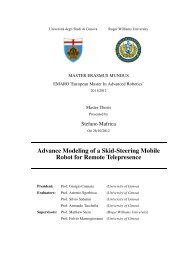East Bay Coalition for the Homeless - Roger Williams University
East Bay Coalition for the Homeless - Roger Williams University
East Bay Coalition for the Homeless - Roger Williams University
Create successful ePaper yourself
Turn your PDF publications into a flip-book with our unique Google optimized e-Paper software.
Run<br />
The nonprofit at <strong>the</strong> “Run” stage uses one or more social media tools and is strategic, identifying key result areas and<br />
key result areas and key per<strong>for</strong>mance metrics that drive everything <strong>the</strong>y do. They also have a <strong>for</strong>mal ladder of engagement<br />
and know how to measure it. They inderstand <strong>the</strong> importance of visualizing <strong>the</strong>ir networkds and measuring<br />
<strong>the</strong>ir relationships. At this level, and organization is religiously practicing basic measurement practices.<br />
In a “Running” organization, social media is not in a silo or guarded by one person or department. With a social media<br />
policy in place and a more social culture, <strong>the</strong> organization in som<strong>for</strong>table with working transparently and working<br />
with people outside its organization, like free agents. They know how to use measurement to identify <strong>the</strong>se influencers.<br />
The board is also using social media as part of its governance role.<br />
The main problem <strong>for</strong> “Runners” is scaling. To build internal camapcity <strong>the</strong>y may need to bring on a half–or full<br />
timestaff person who serves as a community manager, building relationships with people on social media or new<br />
technology plat<strong>for</strong>ms. This social media point person also works internally as a network weaver or trainer to help<br />
departments and individuals use social media to support <strong>the</strong> organization’s programs.<br />
“Runners’ effectively integrate social media and emerging technologies such as mobile across all communications<br />
channels and know just <strong>the</strong> right combination of measurement tools to evaluate <strong>the</strong>ir per<strong>for</strong>mance. “Runners” have<br />
strong capacity in content creation as well as repurposing or remixing across channels. They use an editorial calendar<br />
and have an editorial process in place on a weekly or monthly basis to create, coordinate, and curate content across<br />
channels. They are routinely tracking <strong>the</strong> per<strong>for</strong>mance of <strong>the</strong>ir content by channel, <strong>the</strong>me, topic, time of day, and<br />
o<strong>the</strong>r factors and making adjustments based on measurement.<br />
They use crowdsourcing to create and spread content and build <strong>the</strong>ir network. Runners also incorporate social fundraising<br />
as part of <strong>the</strong>ir fundraising tool box, knowing that community engagement is as important to measure as<br />
dollars raised. They also work with influencers or champions in a <strong>for</strong>mal way as implement social media strategy in<br />
collaboration with partners to build <strong>the</strong>ir network.<br />
At this stage, <strong>the</strong> nonprofit has an organization-wide system and dashboard <strong>for</strong> collecting measurement data that is<br />
shared with different departments. Decisions are not based solely on a data or intuition, but multiple sources. Managers<br />
hold weekly check-ins to evaluate what’s working and what’s not across communications channels, as well as, any<br />
specific social media feedback received that would help shape our future campaigns or social media use.<br />
At this stage it monitors feedback from target sudiences in real time but supplements that in<strong>for</strong>mation with trend or<br />
survey data. The organization may work with measurement consults or specialists to improve skills and capacity and<br />
it provides training and professional development <strong>for</strong> staff to learn how to use measurement tools.<br />
Fly<br />
Organizations in <strong>the</strong> “Fly” state have mastered everything at <strong>the</strong> running stage and internalied it. Flyers create a culture<br />
of public learning <strong>for</strong> both individuals and <strong>the</strong> entire organization. They embrace failure and success alike, and<br />
learn from both. The organization uses data to make decisions, but leaders understand how to lead from <strong>the</strong> heart as<br />
well as <strong>the</strong> head. The organization has documented and shared dramatic results with its stakeholders and peer organizations.<br />
Flyers are part of a vibrant network of people and organizations all focussed on social change.<br />
119
















